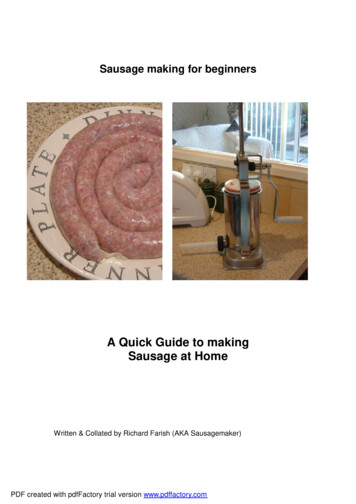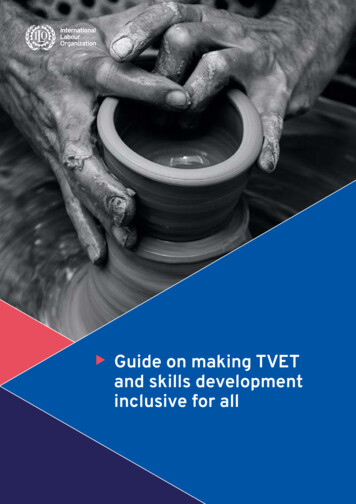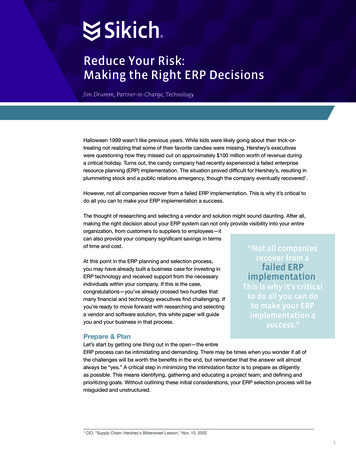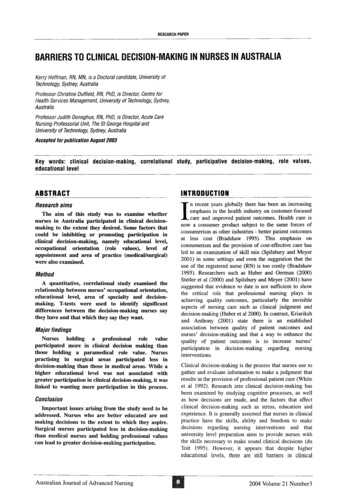
Transcription
Sausage making for beginnersA Quick Guide to makingSausage at HomeWritten & Collated by Richard Farish (AKA Sausagemaker)PDF created with pdfFactory trial version www.pdffactory.com
INTRODUCTIONI could start by telling you that it is a fascinating hobby, but I won’t as you already know that.So lets start with the equipment you are going to need, surprisingly very little is required to getyou going & I would strongly suggest that you keep everything on the small side until you aresure you like the hobby.Standard mincer and fillerThis is one of the best selling models for the beginner sausage maker.It comes with 3 stuffing tubes, instructions and recipe guide and is simple to use, just feed themincer cubes of chilled meat then take out the blade and feed the minced meat through intothe stuffing tubes.The next step from this would be an electric model with sausage making attachments, this isa lot less stressful & easier in the arms.You can often find these for sale in the discounters for around 30 & well worth it.Rusk & FillersRusk is an essential ingredient in sausage making, used by all professional sausage makersand experienced home users alike. Use up to 10% rusk in your sausage to improve thetexture and bite, it helps bind the fat within the sausage and helps retain moisture making amore succulent sausage.Other fillers can be used I have often used breadcrumb, crushed cream crackers, OatmealPotato starch or even a mixture of them all.Soak up rate will vary as a rule rusk is 2 parts water to 1 part rusk & breadcrumb is about 1.5part water to 1 part bread.As for the rest I would suggest 1 part water to 1 part filler.PDF created with pdfFactory trial version www.pdffactory.com
Seasoning Mixes & SeasoningsSeasoning mixes are a good start until you are ready to mix your own, however a word ofwarning here, please make sure what you are using if it is a mix then the probability is that therusk is already included & the usage will be around 12.5% -15%.If it is a seasoning then the usage is more like 2.5%Further on in this guide we will look at some seasoning recipes.CasingsHog casings are best to start with as they are easier to work with than the delicate sheepcasings and produce a good thick sausage.These casings should be soaked in water for at least 2 hours prior to using & then re washedto remove the salt.These are supplied in salt. Use what you need and once resealed in a Ziploc type bag,casings can be stored for months in the fridge.Collagen Casings are dry casing that do not need to be soaked before use and therefore arevery good at storage, these are available in various sizes, however be careful as mostsausage horns are tapered & the casing cannot be pushed on easily.If you intend to use this type try & get a straight edged sausage horn.How much casing to use will be dependant upon the diameter of the casing, I tend to use28mm hog or collagen & will use about 3ft per lb, 18 - 20mm sheep casing or collagen useabout 5ft per lb.Other EquipmentNext we need to look at the other equipment you will require all of these can probably found inyour kitchen.Kitchen Scales,Mixing bowls,Knives and spoons.PDF created with pdfFactory trial version www.pdffactory.com
MeatsNow that we have all the equipment we now need to look at what meats we are going to use,this will depend on the sausage that you are going to make.Pork is the most popular and as luck would have it the least expensive at least here in the UK.Use Pork Shoulder, belly pork & pork fat although you can use any part of any animal youwish.Beef do not use all beef in a sausage as it tends to end up like burger in a tube, use flank,shin, or cheap mince (This will have about 15-20% fat)Lamb or Mutton is good for Middle Eastern type sausageChicken & Turkey are very good for low fat style sausageApproximate Lean to Fat Ratio’sMeat CutPork ShoulderPork BellyPork JowlBeef FlankBeef ForequarterBeef Mince (Cheap)MuttonLambChicken & TurkeyMeat Trimmings (Any Type)ApproximateLean Meat %80605075858080809550ApproximateFat %2040502515202020550HygieneNow for the most important part although I am not going to dwell upon it as I assume you arefamiliar with the concept. Sausage making is no more dangerous than any other form of foodpreparation, botulism; tapeworms & trichinosis are not solely attributable to sausage.However when you are chopping, mincing and mixing raw meats with other materials &stuffing them into a length of gut, it is fair to say the risk of contamination is higher than takingout a joint of beef & placing it in the oven.So before you start please ensure that everything you are going to use is clean, I tend tosterilise with boiling water & spray with a sterilant.Do not forget your hands.PDF created with pdfFactory trial version www.pdffactory.com
Let’s Get StartedA basic sausage would be something like this80% Pork2.5% Seasoning6.5% Rusk11% WaterSo if we intend to make a kilo of sausage we need the following800g of pork (you could use half shoulder & half belly pork for this trial)25g Seasoning65g Rusk110g WaterYou really want about 20 – 30% fat; this will give you a moist succulent sausage.Start by cutting the pork into 1” dice or small enough to pass through the mincer, when this isdone place in the refrigerator to chill or put in the freezer for a short while.Meanwhile weigh up the seasoning, rusk & water.Secure the mincer onto the table top and soak about 6 feet of casing in water to remove thesalt.Now that the meat is well chilled mince it through the mincing blade into a bowl large enoughto add the other ingredients to. I tend to mince on the large holed plate at this stage.Add water & spices to the minced meat & mix vigorously to ensure the spices are welldispersed; you should also be able to feel the meat mixture changing from loose wateryfeeling to a tight texture dependant on the amount of mixing you do.Next add the rusk & mix well in.Now replace the mincing blade with the small holed plate & mince though againNext change the mincing plate to a sausage stuffing horn & wash the inside of the sausagecasing by running tap water through them if using fresh casings, once this is done slide themonto the sausage horn.Now put you meat mixture back through the mincer & form the sausage as it come out (Youmight find it useful to have someone pushing the meat through while you attend to the stuffingside of the operation. In any case only put small amounts of meat into the stuffer at a time thismakes it easier to feed.Hold the casing lightly with your index finger & thumb and allow the meat to fill the casing butnot too tight or it will burst.Try not to get any air pockets in the sausage as you are filling.Don’t worry you will get the hang of it soon.Once the sausages are made you may link them if you wish or leave it in a coil likeCumberland Sausage.Place in the refrigerator over night for the flavour to develop this is called blooming bysausage makers.PDF created with pdfFactory trial version www.pdffactory.com
Linking SausageStart with a length of sausage in the casing not too tightly packed.I am right handed so you need to remember this while I try to explain how this is done.With your left hand extended as if to shake some ones hand hang a length of sausage over toform a horse shoe, with your thumb press down onto you fore finger on your left hand(remember I am right handed), move this link to the bottom of your hand & make a horseshoe again.You now have a link hanging below the palm of your hand with the rest of the sausagehanging over the back of your hand.At the place where you squashed the link you press this against the piece of sausage hangingover your hand. Twist it around and remove the horse shoe from your hand, pass the linkthrough the middle. That the first link made it won’t look like much but the first never does.Now let the three links you have just made hang below your hand (Palm side) and form ahorse shoe over your hand, twist it with the top of the link you have made earlier slide this offand bring a piece of sausage up as if you were drawing a line through the horse shoe push asmall amount of sausage through the horse shoe and where they cross press down with yourfinger & thumb. Now take one of the sides of the horse shoe and push it through between thecentre link& the outer wall of the horse shoe you will need to twist this as you do it. If youhave pushed sufficient through the horse shoe it should twist very easily, if it breaks then youhave either overstuffed the casing or you need to push more through next time.Now let the links you have just made hang down as before & repeat.Remember practice makes perfect I promises you will soon get the hang of it.The next day it’s over to you.Cook them slowly in a frying pan or grill & enjoy.How much casing do I need?TextureTexture is another question that seems to pop up now and again, the things that affect textureare:WaterMeatSaltPhosphateTemperatureMixing timeMincingJust about everything really!To take them one at a timePDF created with pdfFactory trial version www.pdffactory.com
WATERIn essence the more water less texture or at least you would think, but not always as this canbe used to form an emulsion with soya protein, if you make an emulsion with say cookedrinds, water & soya protein in the following amounts you can get an emulsion that gels hardenough to stand on5kg water,5kg Pork Rind (Cooked & Minced)1Kg Soya proteinAlso do not be tempted to make sausage without water, I know you will find people telling youto do so & you may even find recipes that are free from this, but as a general rule use it.It is needed to penetrate the meat cells & carry in the salt; this in turn extracts myosin (Thebinding protein, much like gluten in bread) & helps the bind & gives texture of the sausageMEATMeat it self will give a good texture but only if it is treat well.Just think of frozen mince you buy in the supermarkets, when you brown this in the pan it isalmost like dust. This is not because it’s cheap meat it is because it is minced from a frozenblock of meat.If you mince fresh meat you get a nice flow of meat fibres while mincing this in turn can thenre-bind in cooking & processing, however if you freeze the meat solid then the fibres are instraight lines & the mincing head chops them in to tiny pieces (Humpty Dumpty syndrome).So chill you meat well but do not freeze just enough so it goes through the mincing headwithout the fat smearing or getting sticky.SALTSalt the most important ingredient this little beauty is not only flavour, it is responsible fortexture & preserving.To make the most of this it needs to be in solution so that it can enter the meat cells quickly &extract the protein.PHOSPHATEWhilst a lot of people will not use any of this unless you are buying pre made seasoningsthought I would cover it with a few lines.It is used to move the Ph of the meat so that if can absorb the water more quickly & thereforeaid the texture.Too much will give you a texture like rubber so use sparingly & only at the recipesrecommended rate. It will also give a metallic taste if used to high.TEMPERATURETemperature can be an enemy or a friend it really depends on you, if it is controlled then thelater is true.When making emulsified style sausage you need to chop the meats very hard up to atemperature of about 10c, then you must bring the temperature back down quickly, this isdone by adding crushed ice to the mix after you have formed your emulsion.Using temperature this way you can make some very good frankfurter sausages with a snapthat could be heard in the next room.MIXING TIMEMixing time is really simple the longer you mix the tighter the texture will be, so if you wantloose textured sausages then only mix until the water is absorbed & if you want a nice tightsausage mix a little longer.I would suggest that you mix by hand to start with this way you will learn about absorption &texture together.PDF created with pdfFactory trial version www.pdffactory.com
MINCINGThe last one I will touch upon is mincing and again it is fairly simple the smaller you mince thetighter the sausage becomes, provided as said before that the meat is not frozen.I always start of mincing through the largest plate available & then mix the meat, water,seasoning & rusk or bread crumb, before re mincing through a 5mm or smaller plate.I like the texture this gives.Sausage TypesThere are far too many sausages to list as every country in the world has a vast array ofsausage products & there are many books covering this area, including a lot of free recipeson the internet, I have listed the main ones here in the UK but even here there are literallythousands.PorkTraditional for all areas, & flavoured with just about anything you can think of, some havestrong spices like paprika or cracked black pepper other have ginger, nutmeg, clove or herbs.Pork & Leek, Cumberland, Cambridge, Lincolnshire etcPork & BeefOnce the biggest selling sausage in the UK but fell out of favour due to BSEOxford sausage is one of these types of sausage being made with Pork & vealBeefTraditionally from the highlands of Scotland & the Midland in the UK & mixed with pepper ortomatoLambWith Mint or Rosemary with Garlic, Red wine & MustardChicken & TurkeyThe perfect meats for those wanting a low fat type sausagePDF created with pdfFactory trial version www.pdffactory.com
RECIPESRight this is the section you really want, I have included the Devro sausage menu book, apublication that was given to me many years ago by Devro when I was a product developerfor the largest frozen sausage manufacturer in the UK.This publication is a collection of recipes from around the world & carries no copy writeSo I am assuming that I can copy this for your reference.There are also some other recipes from the web & where I know the authour I have giventhem full credit.Basic Pork SausageThe beauty of this recipe is that it can be the basis of all your pork based sausages.Al
You can often find these for sale in the discounters for around 30 & well worth it. Rusk & Fillers Rusk is an essential ingredient in sausage making, used by all professional sausage makers and experienced home users alike. Use up to 10% rusk in your sausage to improve the texture and bite, it helps bind the fat within the sausage and helps retain moisture making a more succulent sausage .











